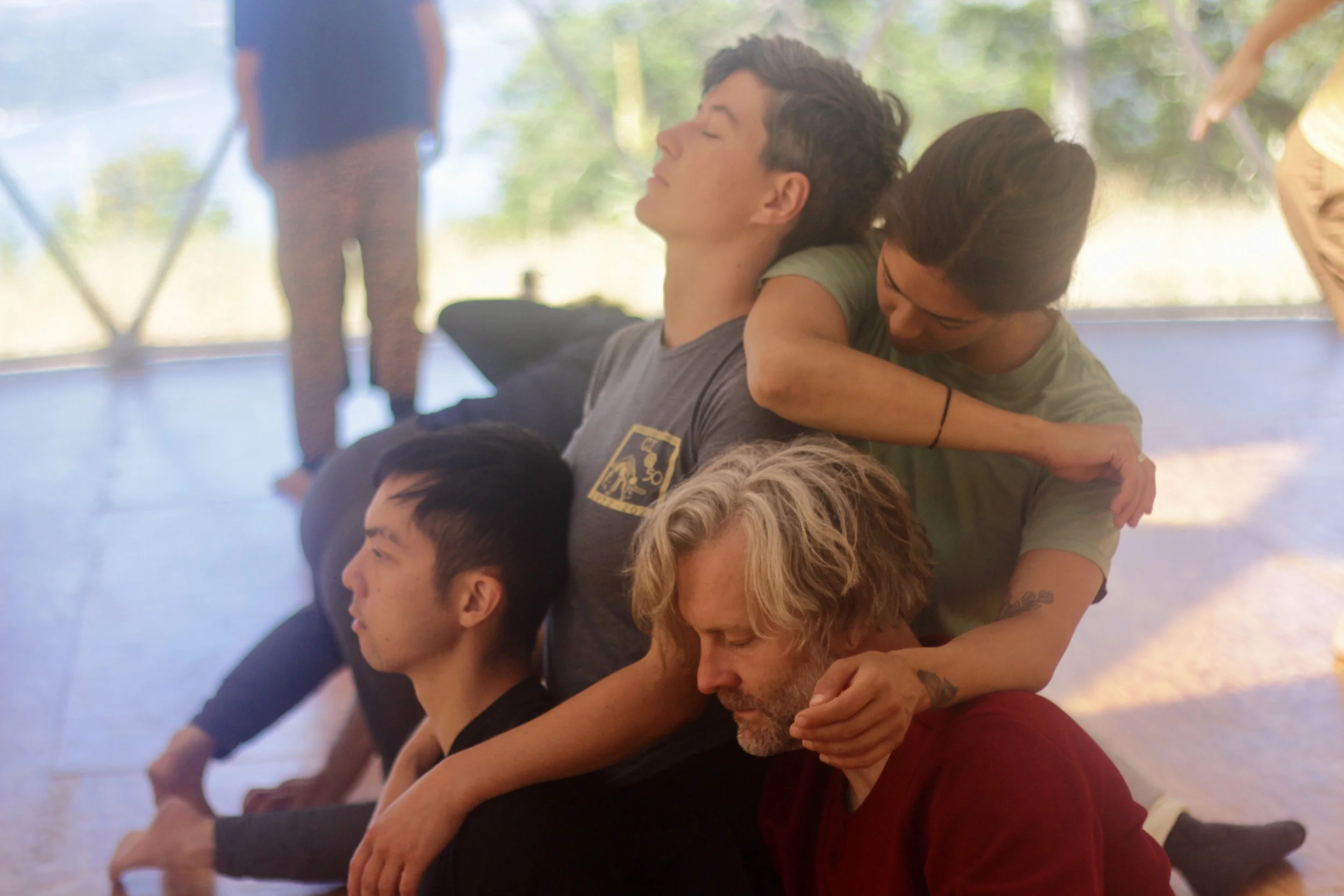Seven Reasons I love Contact Improvisation
An ode to the practice that has positively changed every dimension of my life
PC: Alizah Cameron, Rhizome Springs on Salt Spring Island, BC
It’s difficult to satisfyingly describe what contact improvisation (CI) is. Sometimes, I think of it as a moving meditation on physics and attunement. But, it’s also so much more than that!
Every CI dancer I know would likely describe the practice differently, especially from country to country.
Though it originated in the United States in the 1970s, it is practiced all over the world and has perhaps the strongest presence, or at least I’ve heard such, in Buenos Aires, Argentina.
In this post, I hope to give texture to what CI is while also celebrating how positively life-changing this practice can be.
1. CI offers a clever and unique opportunity to tone and regulate our autonomic nervous system
Being a huge autonomic nervous system nerd, I see CI as a practice that powerfully works with the threat/safety aspect of our nervous system.
What is often most healing and supportive to this part of us is safe and diverse co-regulation with other mammals and especially, other humans.
For a moment, just think about the diversity of co-regulation being with a dog can offer. The relationship provides co-UPREGULATING activities like moving briskly on walks, wrestling, and roughhousing. AND, the relationship provides soothing co-DOWNREGULATING activities like gentle touch, cuddling and passive, still physical contact.
How often do humans interact with one another in both of these fashions? We have plenty of cultural examples of people upregulating together (sports, martial arts, races). Now, what if people also felt safe enough to engage in gentle touch and stillness with the same folks they upregulate with?
While animals can offer incredibly beneficial co-regulation to people and feel especially safe when other humans feel scary, our nervous system is also wired to seek safe, diverse co-regulation with other people.
And this is what we do in contact improv!
To me, the most nourishing contact improv experiences happen in spaces where consent culture is nurtured, people who are hesitant or have non-dominant identities in the space feel welcome, and community care is evident, especially when harm happens.
These all help to create safe cues for our nervous system to courageously move through the incredibly diverse co-regulation opportunities that the practice offers.
2. It is profoundly comforting to the part of me that wants to stop hearing and using words while still feeling connected to others
PC: Barron Peper, workshop in Spokane WA
CI is non-verbal and often, though not always, practiced without music. If there is music, it usually does not have any lyrics.
Words are important to use when physical cues aren’t being perceived. For example, if hair is being caught and pulled, or we need to communicate about an injury or boundary. But unless we are workshopping a specific skill in a class setting, conversations are generally discouraged while engaging in the form.
Verbal language is an incredible gift of being human AND it requires us to use parts of our brains that can take us out of our bodies.
By limiting our verbal processing capacity while still engaging intimately and creatively with other bodies, our other senses come alive and huge parts of us get to be more expressed and met through shared touch and movement.
As a person who regularly reaches a point of saturation with verbal relating, I find this aspect of the form incredibly soothing.
3. CI teaches us how to be close and intimate without sexual escalation
PC Barron Peper, Exit Space Studio in Seattle, WA
A 1966 study showed that American friends being observed in a cafe setting talking for an hour touched each other an average of 2 times, while in that same timeframe and setting, close friends in France touched 110 times, and in Puerto Rico, 180 times. The Brits touched exactly zero times.
Considering the British once had colonies on every continent and have historically held the largest empire in human history, hearing about this study really helped underscore the driving forces of overall global trends toward isolation, individualism, and material over relational security.
Dominant culture in the United States and Great Britain are so twisted when it comes to intimacy and physical closeness.
Practically any form of real physical closeness can feel like it insinuates sexual desire or sexual expectation. Additionally, same gender touch and closeness can often trigger intense homophobia.
Thus, so many of us are chronically missing out on a huge spectrum of safe, co-regulating touch that is possible.
And yes, closeness of this kind can feel very pleasurable. When we are just starting this form, we may not be used to experiencing pleasurable or intimate touch that is not sexual in nature. It can be easy to experience sexual arousal or fear of others’ sexual arousal. This can, of course happen at any time, even when we are deeply practiced, but especially when we are unpracticed at being close like this.
I am grateful for the contact spaces I have been in where we talk about this and encourage practices of taking personal responsibility, attuning to our self and others, not pursuing sexual gratification in the space, or using the space to try to find dates or hook-ups.
CI has been incredibly healing to me for these reasons. Before I found CI, I didn’t know how to experience the kind of closeness this form offers without thinking of it as sexual.
4. The form has made the world feel more like a playground and dance partner
CI can also help our body find more comfort and support in relationship with the sensory physical world beyond connection with other humans. It has inspired me to endlessly create and improvise with my body in relationship to the world around me.
Within a year of discovering the form I began to experience the physical world differently. Perhaps similar to a parkour athlete, the world became a physical playground.
But perhaps expanding on the parkour athlete’s experience, the world also became a sensitive and receptive cuddler.
Life has so much more texture and physical resource than I ever knew or was taught.
5. My physical agility and proprioceptive confidence have skyrocketed
PC: Jada Sun, Finnish Hall Berkeley, CA
Proprioception is our ability to sense our body and where it is in space without seeing it.
Agility is our ability to safely, quickly, and efficiently organize our body when an unexpected movement occurs.
I think contact improvisation is the single best movement practice for developing these skills. In a duet, we are improvising simultaneously while staying connected. I never know what is going to happen next, but my movement is reliant on your moment-to-moment decision-making just as your movement is reliant on mine. Now make this a trio, or quartet and you get the idea….
In the photo above, I’m flying on top of my dear friend, Michael Ducott. This just happened. We didn’t plan it. Michael and I are both athletic and relatively able-bodied. This kind of dancing is not realistic for all nor necessary to be “doing contact improv.” It took us both years of dedicated study and practice to be able to move like this. And, boy howdy, is it fun.
6. Contact Improv deconditions gender norms and homophobia
PC Barron Peper, Exit Space Seattle
I can’t think of a single other creative and intimate partner movement form that doesn’t have foundations routed in heteronormativity and binary gender roles. Think: tango, swing, salsa, ballroom, figure skating duets, etc.
From its foundations in the 1970s at Oberlin College in Ohio, contact improvisation has provided space for people to athletically, expressively, and sensually collaborate without regard to gendered roles.
In CI, it is incredibly common to see people having same-gender intimate dances. I regularly witness cisgendered, straight men, for example, relating with one another in ways that are completely unfathomable in most spaces - with tenderness, affection, sensuality, and cooperation.
7. I meet the most embodied and creative people who are skillful at practicing consent
PC Barron Peper, Vashon Island, WA
I obviously do not feel this way about everyone I meet practicing CI. But over the years, doing contact in many different locations and communities, I’m awestruck at the quality of humans that I’ve met through the form.
Contact Improvisation, when taught skillfully, strengthens the learners’ ability to sense their own desires and limits and to sense and respect corresponding cues in others’ bodies.
When I am around my friends who practice contact improv, I generally feel much more comfortable navigating emotional and physical boundaries and desires within the relationship. This can really bolster my sense of security and expand creative possibility in these connections.
PC: Jada Sun, Finnish Hall in Berkeley, CA
Huge, huge thank you Contact Improvisation, all of my teachers, and fellow dancers.
And thank you for reading. I would love to hear any of your thoughts or reactions to this blog post!
Click below if you would like to stay in the loop on my writing and offerings.
contact: JP@touchandchange.me








